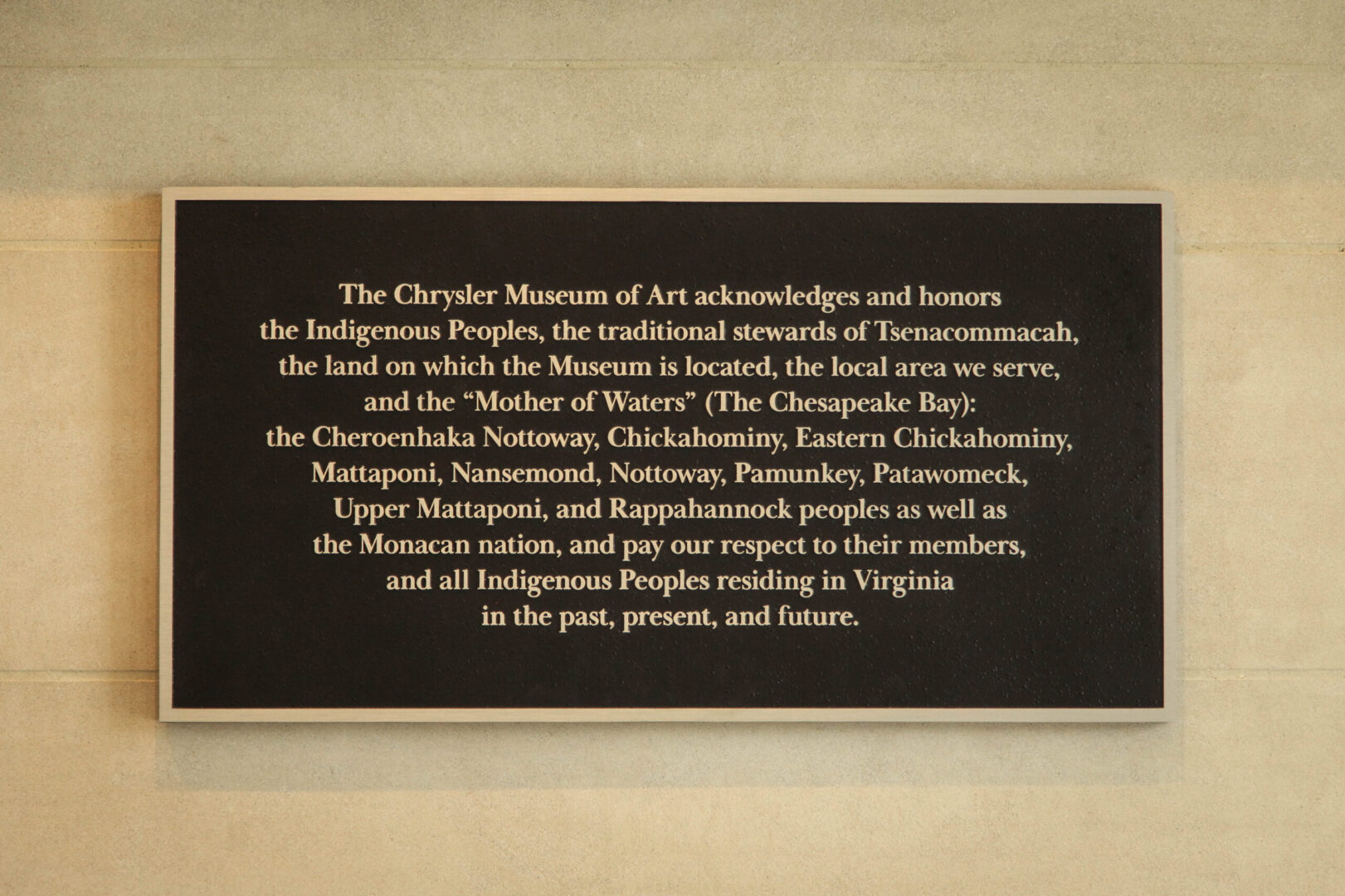- Open today, 10 am to 5 pm.
- Parking & Directions
- Free Admission
Honoring the Original Inhabitants
The Chrysler Museum of Art acknowledges and honors the Indigenous Peoples, the traditional stewards of Tsenacommacah, the land on which the Museum is located, the local area we serve, and the “Mother of Waters” The Chesapeake Bay: the Cheroenhaka Nottoway, Chickahominy, Eastern Chickahominy, Mattaponi, Nansemond, Nottoway, Pamunkey, Patawomeck, Upper Mattaponi, and Rappahannock peoples as well as the Monacan nation, and pay our respect to their members and all Indigenous Peoples residing in Virginia in the past, present, and future.

The Journey of the Chrysler Museum’s Land Acknowledgement
The Chrysler Museum formed a Native Advisory Committee in 2022 to help shape the institution’s programming and indigenous collection through support and feedback. From this committee, the Land Acknowledgement was initiated. In December 2022, the Chrysler Museum of Art Board of Trustees unanimously voted to approve the proposed acknowledgment. On July 21, 2023, the Chrysler Museum of Art unveiled a bronze plaque recognizing the Indigenous Peoples, the traditional stewards of Tsenacommacah, the land on which the Museum is located. This plaque, which has been placed in Huber Court, acknowledges and affirms the Chrysler Museum’s commitment to honoring the art and cultural heritage of Indigenous Peoples from across the globe.

What is a land acknowledgment?
A land acknowledgment is a statement that recognizes and pays respect to the original inhabitants of a particular place. It aims to acknowledge the historical injustices faced by Indigenous communities due to colonization and serves to honor the original stewards of the land on which we now reside.
Why is a land acknowledgment important to the Chrysler Museum of Art?
While a land acknowledgment is not enough, it serves as a starting point in recognizing how Indigenous Peoples have been marginalized through historical events and systemic injustices. Additionally, it creates awareness of the ongoing presence and contributions of Indigenous Peoples within our community, expresses gratitude to those whose territory on which we reside, and honors those who have been living on and cultivating this land from time immemorial.
We acknowledge the Indigenous Peoples of this place to indicate our commitment and accountability to act in ways that address historical and contemporary trauma through a culture of inclusion and respect.
Who has contributed to creating this language?
The Native Advisory is made up of twelve individuals from across the state representing indigenous cultures:
• Ken Custalow – Chickahominy Eastern Division, Tribal Relations Manager, Dominion Energy
• Sylvia Nery-Strickland – Member, Cheroenhaka Nottoway Tribe
• Keith Anderson – Principal Chief, Nansemond Indian Nation
• Lynette Allston – Chief, Nottoway Indian Tribe of Virginia
• Shaleigh Howells – Cultural Resource Director & Museum Director, Pamunkey Indian Tribe
• Bernard Means, Ph.D. – Teaching Assistant Professor, Virginia Commonwealth University
• Nikki Bass – Nansemond Indian Nation, Tribal Council Vice Chair
• Danielle Moretti-Langholtz, Ph.D. – Curator of Native American Art, Muscarelle Museum of Art
• Kevin Krigsvold – CEO/President, Pamunkey Indian Enterprises-Professional Services
• Michael Cloud Butler – Ojibwe American Indian from Lac Courte Orielles, Wisconsin & Artist
• Hans VonKruger – SVP, Market Executive – Bank of America
• Lee Lockamy – Chief Emeritus, Nansemond Indian Nation
Where can I find out more about local Indigenous materials, culture, art, and artists practicing today?
Local Tribal Websites, Museums and Cultural Centers:
• Cheroenhaka (Nottoway) Tribe
• Chickahominy Indian Tribe Eastern Division
• Upper Mattaponi Indian Tribe
Native Governance Center:
What actions is the museum taking toward a more inclusive interpretation of the past?
The Chrysler Museum is committed to fostering a diverse and inclusive environment from our programming to our collections. With that in mind, the Chrysler has taken the following steps:
• Re-examining the interpretation of materials in our collection to include their historical context and contemporary viewpoints
• Identifying Indigenous art in the collection and including it in the Museum installation plans in the context of American art as well as Mesoamerican art
• Actively consulting with the Native Advisory Committee and local experts about our programming and upcoming exhibitions, which currently include Early Days: Indigenous Art from the McMichael Canadian Art Collection (May 24–September 1, 2024) and Clearly Indigenous (June–September 2025).

